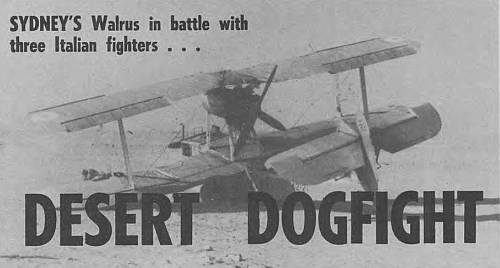- Author
- Collins, Vice Admiral Sir John
- Subjects
- Ship histories and stories
- Tags
-
- RAN Ships
- HMAS Sydney II
- Publication
- March 1975 edition of the Naval Historical Review (all rights reserved)

IN RESPONSE TO THE ARTICLE ‘Pusser’s Bus’ which appeared in the December issue, Vice-Admiral Sir John Collins, Sydney’s Captain in the Mediterranean, writes: ‘I feel sure that Sydney’s Walrus should have got a mention in the article on these aircraft.’ A2- 21 was engaged in spotting for the naval bombardment of Bardia when attacked by enemy fighters. Here is the account of the engagement by Vice-Admiral Sir John Collins.
On 20th June, Orion, Neptune and Sydney, the French battleship Lorraine with Stuart, Decoy, Dainty and Hasty escorting, sailed for the bombardment of Bardia. At 0510 on 21st June the Walrus aircraft was catapulted to spot Sydney’s fire and half an hour later the bombardment commenced, 150 six inch HE shells being fired. Large fires as from oil and petrol dumps were observed in the clouds of dust and smoke.
Communications with Sydney’s Walrus ceased after the second salvo was reported on target. The slow and cumbersome aircraft had been set upon by fighters. Flight Lieutenant Thomas McBride Price, the pilot and Lieutenant-Commander Bacon, the observer, believed they were being attacked by three Italian CR42’s.
Price later commented:
‘With our slow speed we had no chance to manoeuvre. Anyhow, the first burst from the Italians had shot away our aileron controls. Bursts from the second plane, right on our tail, riddled the rudder and the after section of the hull until it looked like a sieve. Most of the tail plane struts were shot away. And we could see a line of bullet holes sawing off the port lower mainplane. It seemed dollars to doughnuts that the old Seagull would be blown into pieces within a few seconds . . .’
The Walrus lost height quickly and levelled out at 2,000 feet. The Telegraphist Air Gunner meanwhile had kept up a steady fire on the attackers with the result that the fighters broke off the attack.
‘We were dead meat, actually‘, said Price, ‘but they didn’t seem to like our bullets. Or perhaps they thought we were done, anyway‘.
Clearing the defences of Bardia, Flight Lieutenant Price nursed the heavily damaged aircraft back to the advanced British outposts at Sollum but the country was too rough for a landing. He flew on to Matruh where he set the wrecked amphibian down on to the tarmac, which was still smoking from an Italian bombing attack. Sydney’s Walrus was a complete write-off. It subsequently transpired that the fighters were British and thought the unfamiliar biplane amphibian was Italian.
Lieutenant Price was awarded a well-earned DFC for this courageous piece of work.




